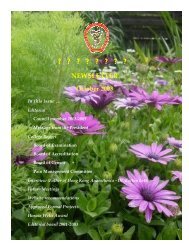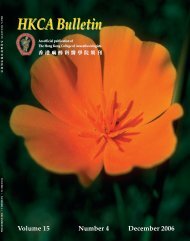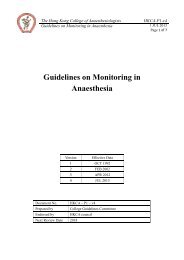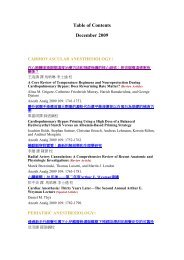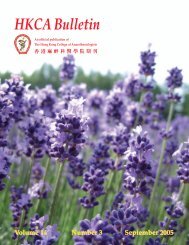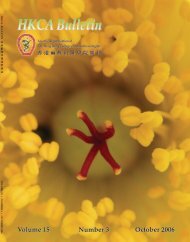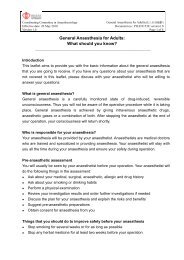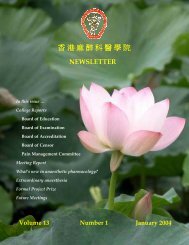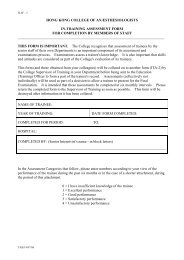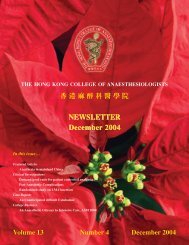Table of Contents — September 2012, 115 (3)
Table of Contents — September 2012, 115 (3)
Table of Contents — September 2012, 115 (3)
You also want an ePaper? Increase the reach of your titles
YUMPU automatically turns print PDFs into web optimized ePapers that Google loves.
in the conductive properties <strong>of</strong> different C-fiber classes on acute administration <strong>of</strong> lidocaine<br />
(nonselective NaV blocker) and lacosamide (selective enhancer <strong>of</strong> NaV slow inactivation).<br />
METHODS: Single-fiber extracellular recordings from saphenous nerves were performed. We<br />
classified C-fibers according to mechanical responsiveness and amount <strong>of</strong> activity-dependent<br />
slowing (ADS) <strong>of</strong> conduction velocity. Lidocaine (4 mM; 100 μL), lacosamide (4 mM; 100 μL),<br />
or saline was injected intradermally at the stimulation site, and changes <strong>of</strong> fibers' conductive<br />
properties were assessed.<br />
RESULTS: Conduction latencies evoked by lidocaine were more prominent in<br />
mechanosensitive (5.5%± 2.1%) than in mechano-insensitive nociceptors (2.5% ± 1%), whereas<br />
lacosamide increased conduction latencies to a greater extent in the mechano-insensitive (3% ±<br />
1%) than in mechanosensitive C-nociceptors (2% ± 0.9%). Lidocaine, but not lacosamide,<br />
increased electrical thresholds in all mechanosensitive, but not in the mechano-insensitive, C-<br />
fibers. Lacosamide blocked conduction and, in addition, reduced ADS in mechano-insensitive<br />
nociceptors significantly more than in mechanosensitive nociceptors (ΔADS: 2.4% ± 0.5% vs<br />
1.6% ± 0.5%), whereas lidocaine had opposite effects. Saline had no significant effect on the<br />
conductive properties <strong>of</strong> C-fibers.<br />
CONCLUSION: Local application <strong>of</strong> test compounds in pig skin allows for functional<br />
assessment <strong>of</strong> steady-state and use-dependent modulation <strong>of</strong> sodium channels in nociceptive and<br />
nonnociceptive C-fibers. Increased analgesic specificity might derive from selective<br />
enhancement <strong>of</strong> slow inactivation <strong>of</strong> sodium channels.<br />
一 項 關 於 外 科 術 後 血 糖 控 制 的 新 型 電 腦 化 記 憶 褪 色 演 算 法<br />
A novel computerized fading memory algorithm for glycemic control in postoperative<br />
surgical patients.<br />
Mayumi Horibe, MD*†, Bala G. Nair, PhD*, Gary Yurina, CRNA†, Moni B. Neradilek, MS‡<br />
and Irene Rozet, MD*†<br />
From the *Department <strong>of</strong> Anesthesiology and Pain Medicine, University <strong>of</strong> Washington, Seattle,<br />
Washington; †Department <strong>of</strong> Anesthesiology, Veterans Affairs Puget Sound Health Care System,<br />
Seattle, Washington; and ‡The Mountain-Whisper-Light Statistics, Seattle, Washington.<br />
Anesth Analg <strong>September</strong> <strong>2012</strong> <strong>115</strong>:580-587<br />
背 景 : 高 血 糖 常 見 於 危 重 病 人 , 並 且 其 與 患 者 發 病 率 和 死 亡 率 的 增 加 相 關 。 為 了 更 好 的<br />
控 制 血 糖 水 準 , 我 們 最 近 開 發 了 一 種 新 型 電 腦 化 記 憶 褪 色 (FM) 演 算 法 。 在 本 項 研 究<br />
中 , 我 們 在 外 科 重 症 監 護 室 (SICU) 患 者 中 評 估 了 這 項 演 算 法 的 安 全 性 和 有 效 性 , 並 且<br />
將 之 與 在 我 們 機 構 中 使 用 的 現 有 的 胰 島 素 輸 注 演 算 法 ( 佛 吉 尼 亞 (VA) 演 算 法 ) 相 比<br />
較 。<br />
方 法 : 我 們 開 發 了 一 項 電 腦 程 式 來 演 算 FM 演 算 法 和 VA 演 算 法 。48 位 擇 期 手 術 患 者 被 隨<br />
機 分 配 , 接 受 按 照 FM 演 算 法 或 是 VA 演 算 法 得 出 的 胰 島 素 泵 輸 注 。 在 SICU 中 , 胰 島 素<br />
泵 的 使 用 是 將 手 術 室 中 帶 入 的 繼 續 輸 注 , 或 是 當 患 者 血 糖 水 準 超 過 目 標 水 準<br />
(140mg/dL) 時 啟 動 胰 島 素 泵 。 每 小 時 對 患 者 進 行 血 糖 監 測 並 將 資 料 登 錄 電 腦 程 式 中 ,<br />
然 後 得 出 出 下 一 次 的 胰 島 素 劑 量 。 在 SICU 的 第 一 個 8 小 時 使 用 隨 機 分 配 兩 種 演 算 法 , 在<br />
這 之 後 統 一 使 用 VA 演 算 法 。 低 血 糖 ( 血 糖 300mg/dL) 事 件<br />
會 予 以 記 錄 。 此 外 , 我 們 將 使 血 糖 回 歸 目 標 範 圍 (140±20mg/dL) 所 需 的 時 間 、 在 目 標 範



